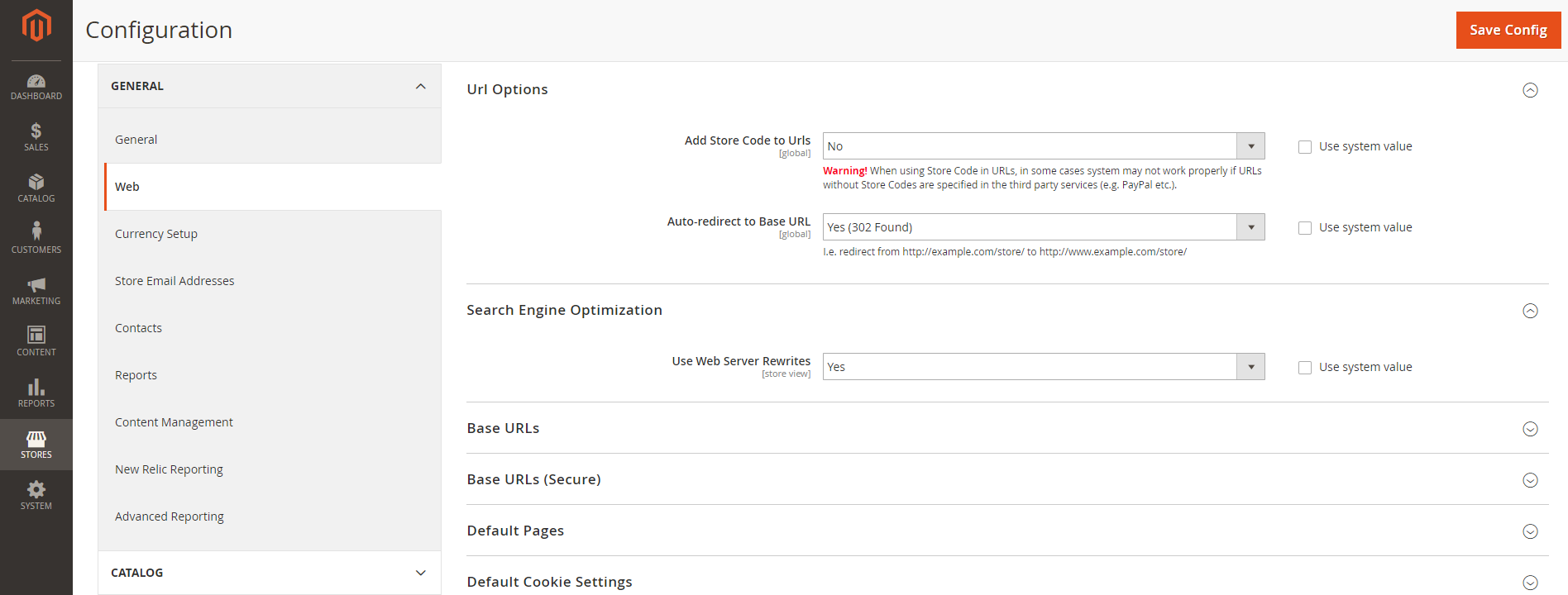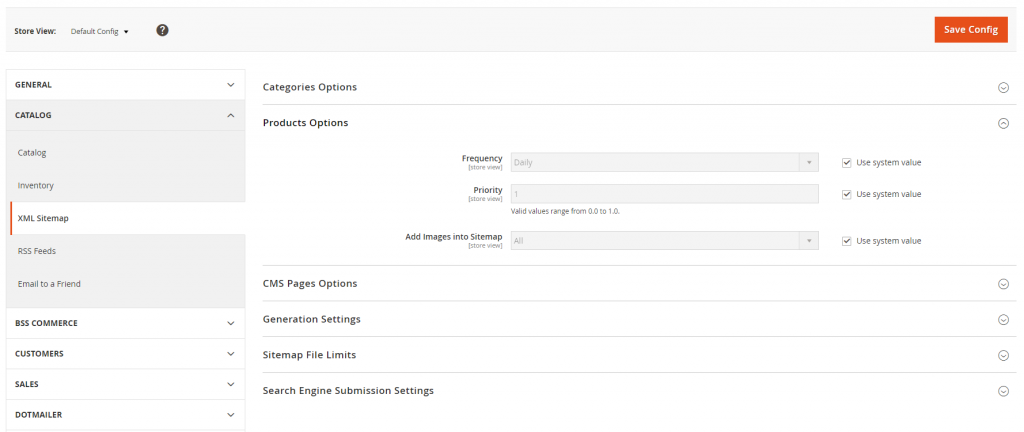Applying 14 Magento SEO best practices above is completely free and easy to do. Still, it can bring a lot better organic traffic to your site, and increase site rankings, and search engine visibility.
BSS Commerce hopes these tips can help you learn how to do SEO for ECommerce site and get some ideas to improve your website SEO ranking and Magento SEO performance.
If you find all the SEO work too hard to do all by yourself, check out this guide to hire Magento SEO agency.
Remember to stay tuned with us. The article will be updated frequently to bring you more useful Magento on-page SEO tips and even Magento SEO tutorials.
If you’re looking to enhance your Magento store with reliable and innovative solutions, the Magento Plugins Store by BSS Commerce is your ultimate destination. As one of the leading Magento extension providers worldwide, we pride ourselves on delivering top-quality products and Magento web development services tailored to optimize your business operations.
Enjoy FREE Installation, 1-Year Support, and Lifetime Updates with every purchase.
CONTACT US today and let our team provide the perfect solutions for your Magento store. We’re here to support you every step of the way!
No marketer can overlook the importance of SEO in their marketing strategy. Thus, this article will show you some Magento 2 SEO best practices to help you learn how to do SEO on your stores.
Magento SEO performance is the decisive factor in the online store’s success. The better Magento SEO optimization you do for your website, the more customers can access your product/service, leading to a bigger chance of brand broadening.
However, Magento SEO optimization is never a simple task, and it is even more complicated when doing SEO for an eCommerce website containing many product lists.
This relationship between Magento and SEO is reflected in the fact that the default Magento supports merchants to better their business.
This is one of the reasons that make Magento 2 become a popular eCommerce website platform is Magento SEO features such as URL rewriting, image optimization, or Google Sitemap.
You can check out Magento 2 SEO Checklist for more details or pay a visit to our Magento SEO Strategies tutorial to acquire useful knowledge and apply it to your SEO with Magento.
The Importance of SEO for Magento Stores
Table of Contents
It’s crucial to note that your website needs to be visible to Internet users. There’s no point in creating good products and services if your target audiences cannot find you.
Moreover, 4 out of 10 online shoppers begin their shopping journey by searching on search engines, and 30% of organic traffic comes from this source.

SEO for Magento is a vital factor in driving traffic and converting sales for your stores.
Top 13 Must-Do Magento SEO Tips
This is the top 13 Magento SEO best practices you should follow right now to boost your sales!
1. Update the latest version of the Magento platform
Magento SEO tip number one is always to update your Magento latest version. New releases will have the best Magento SEO features support updated. This is what you want to have to get a high rank in search engines.
Other than that, upgrading to the latest version contains a lot of enhancements, including Magento SEO performance enhancements, bug fixing, and, most importantly, strengthening the security of your site.
Magento itself always recommends all users upgrade to the newest release version as soon as possible. This contributes to enhancing the efficiencies of Magento SEO help when your website is always updated and refreshed.
Hence the latest version contributes to bettering the Magento SEO performance of websites.
READ NOW about Magento 2 Download & Updates update the newest version for your site.
2. Optimize the Magento SEO URLs
If you search for how to do SEO on Magento, every article mentions that you need to create the Magento SEO URL keys for the web pages. It is better if the URLs of your website have no codes.
In terms of Magento SEO features, you can follow these steps to clean URLs: Store => Configuration => General => Web => URL Options, and then set Add Store Code to URL to “No”.
After this configuration is saved, product/category codes will not be automatically added to your URLs, which makes Magento SEO URLs more friendly.

IMPROVE URL TREE with Magento 2 Import Export URL Rewrites for automation of your URL component and structure.
To radically clean URLs, in the Search Engine Optimization menu, turn Server URL Rewrites to “Yes.” The phrase “index.php” will be removed from your URLs as well.
In general, URLs themselves don’t significantly impact a page’s ability to rank. But they are still a minor ranking factor.
The most important highlight of optimizing the URLs is to improve the user experience. No one wants to see a URL link full of numbers and nonsense letters.
Magento SEO URL friendly gives both humans and bots a more clear view of what the page will be about.
3. Use proper keywords
Magento 2 has default sample content for product titles and descriptions, but it is not standard for Magento SEO practices. You need to edit them by going to Content => Design => Configuration.
The UI will show you a Design Configuration table. Choose, for example, a store view you want to edit. In Other Setting => HTML Head.
Meta title and description should be keyword-rich and unique for SEO in Magento. With the title, one rule is to put important keywords near the beginning of your title as much as possible in order for search engines to realize them more easily.
In the description, the keyword also needs to appear as well. One more thing is eliminating words like “the,” “and” from your title. Do a similar action for the category title and description to make your site more SEO-friendly.
Besides, you had better insert keywords to alt tags for images.

In short, keywords are quite essential for Magento tags SEO (title tags, alt tags). Your site cannot get a high ranking if you forget to put main keywords or use extra keywords in Magento tags SEO.
4. Optimize product images
Other Magento 2 SEO best practices to not forget to optimize product images on your site.
First of all, the name of the image file should accurately and clearly describe what the image is about, other than a series of meaningless words and numbers.
For example, instead of IMG00231, you should name it black-acoustic-guitar. The file’s name eventually becomes part of the image’s URL, so naming your file something in plain English will make your URLs easier to navigate and understand for the search engine.
The alt text of a picture is shown when users hover their mouse over the picture or websites can’t render the image for some reason. When a search engine scans your website, it can not see what’s in your picture. The only thing a search engine can read is the text.
The alt text describes the image to search engines so they can understand them. You can add your keyword in the alt text, but remember to add your keyword with a reasonable dose. This leverages the performance of Magento SEO Marketing which enables images to be ranked in the first positions.
The size of the image is also a thing because it affects the loading speed. Normally, almost half of the e-commerce shoppers will not wait over 3s for a page to load. PNG images are so popular these days, but in terms of small size and quality, JPEGs are better choices over PNGs.
In short, image optimization means Magento SEO optimization.

5. Avoid duplicate content
Having unique content is one of the Magento SEO best practices. Search engine crawlers take it low on-site with duplicate content (multiple URLs pointing to the same or similar content).
To solve this, you should explicitly tell Google which URL is authoritative (canonical) for that page. If you do not do this explicitly, Google will make that choice for you or might consider them both equal weight, leading to unwanted behavior.
That’s also the benefit of the canonical tags – one of the Magento tags SEO.
In the default Magento SEO setting, you can use Canonical Tag for both Product and Category. To enable the Canonical Tag option to figure out this problem. Go to Store => Configuration => Catalog => Catalog => Search Engine Optimization.
Then Set’ Use Canonical Link Meta Tag For Categories’ to Yes, ‘Use Canonical Link Meta Tag For Products’ to Yes. By doing all of these configurations, SEO in Magento will be effectively optimized in every aspect.

Take advantage of Magento 2 ChatGPT to auto generate high-quality & SEO-friendly content for your store!
6.1. Speed up your site
Website speed optimization is another great one in Magento SEO best practices.
The loading speed can influence the site ranking. As Google has stated, low-loading sites are not preferable. Only one lower second can drop the site ranking.
There are various Magento SEO tips for you to speed up your site. Below are some simple but easy ways for you:
- Enable all caching features (Store => Configuration => Advanced => System => Full Page Cache)
Set ‘Caching Application’ to Varnish Cache and then configure a few Varnish configurations such as Access list, Backend port & Backend port. This setup can make your subsequent page load faster without much server load.
- Enable Flat Catalog Categories and Flat Catalog Product (Store => Configuration => Catalog => Catalog => Storefront)
A flat catalog is updated automatically, contains all the necessary data about a product or category in a single table. So that flat catalog indexing can significantly speed up the processing of catalog and cart price rules.
- Merge CSS and JS files (Store => Configuration => Advanced => Developer => JavaScript setting / CSS setting)
Merging the separated JS files / CSS files into one file by just Enable the Merge CSS / JavaScript Options helps to reduce page loading time for your page.
- Reduce the number of external files that can be downloaded from your server
These methods help your Magento SEO optimization get more efficient on Search result page rankings.
6.2. Speed up your site – Advanced mode
The default setting is not enough to lift up your loading time. Yes, in the beginning, your products and visual content are low – therefore, you don’t need to pay much attention to optimizing them in order to make your site run smoother.
However, as an online business, you should expect these files to grow immensely with your shop. And you need to prepare.

EXPLORE LOADING SPEED SOLUTION: Magento 2 Defer JavaScript helps render your website the fastest.
Let me explain.
The way this works is to postpone the Magento Javascript loading till everything from HTML to CSS files is rendered. Therefore, everything vital to the website is put out first and foremost as a priority rather than the unnecessary Javascript snippet.
The faster you deliver the utmost important piece of information, the easier it is to get customers to engage and not bounce back from your website.
7. Generate a sitemap
Sitemaps are vital for SEO purposes – one of the most essential Magento SEO tips shouldn’t be missed. Crawlers follow the links in the sitemap to all your pages of a website and then crawl things back for the search engine. Hence, a sitemap helps crawlers scan every content page with a clearer guideline.
For Magento 1 SEO optimization, you can generate both XML and HTML sitemaps. Unfortunately, Magento 2 only has XML sitemap settings.
If you want to generate an HTML sitemap, you need to customize or use an extension like Dynamic HTML Sitemap for Magento 2 to create one.
To configure the Site Map, for example how frequently the map is updated or what is included, go to Store => Configuration => Catalog => Catalog => XML sitemap.

To generate XML sitemap, go to Marketing => Sitemap. Then add a sitemap and add the name and path for that new sitemap. Then choose Save & Generate. Read more XML sitemap in Magento 2 Generation Tutorial
8. Modify robots.txt file
Why is modifying robots.txt file one of the Magento 2 SEO best practices?
In case you create a site without real products, the Magento SEO feature adds a robots.txt file to your site so that search engines will not index it.
Your site is real, right?
So don’t let the robots.txt file prevent search engines from finding your site.
With default SEO for Magento Ecommerce, the Robot setting is “INDEX, FOLLOW.” In case you want to change it, go to Content => Design => Configuration, then Choose store view you want to change the Robot.txt setting. And then, scroll down to Search Engine Robot. You will find the configuration for it here.
9. Build an internal link network
To get better results for Magento SEO help, building internal links is a Must. By following links, search engine crawlers can define the relationship between the pages, posts, and other content on your website.
The next Magento SEO tip is to build a great network of internal links just by using the default Related product feature.

You can easily link a product with its related items following this configuration: Catalog => Products. Then you choose a product to edit.
Go to Related Products, Up-Sells, and Cross-Sells => Related Products => Add Related Products.
Bonus: Start with Low competitive keywords
Making SEO optimization for a keyword or a group of keywords to top rank needs a lot of work. And it is even more difficult if your site is new and has low authority.
So choosing a high-competitiveness keyword for SEO is extremely time-consuming.
You need to create outstanding content and promote it, so hard to get the result. That’s not a good way to deal with the situation.
Instead of trying to promote competitive keywords, just find the less competitive one and try to SEO them first.
This is actually the quickest way to leverage Magento SEO optimization and grow your search traffic.
Tools like Keywords Explorer can help you figure out which keyword is easier to SEO in Magento via a score named “keyword difficulty” or KD for short.
TAKE A LOOK at Full Magento 2 SEO Guide right now to get every default SEO features supported!
10. Craft your appearance on the SERP
So let’s get this out of the way – Google is the one who decides which snippet they’re gonna show, and it can change depending on the search terms.
However, it’s still your job to create a tidy and eye-catching snippet that will separate your website from others on the SERP. Magento tags SEO is not a choice; it’s a must. If customers don’t click on your link, nothing else matter.

LAUCH NEW SNIPPET with Magento 2 Rich Snippets – the fastest way to be highlighted on Google’s listing page.
In addition, this module also supports shaping your sharing profile with Open Graph and Twitter Card. Such improvement will increase your click-through rate and help you gain the true power of social sharing.

11. Include customer reviews
Google is setting its algorithm in the direction of “for users and by users”. Therefore, it prioritizes websites with better customer reviews. And not only that, but reviews are also a source of keywords! This feedbacks are often called for interaction and you can strengthen your relationships with them through a conversation like this.
Bonus Magento SEO tip: If you’re a local business, reviews will be your best bet to appear on the 1st SERP. Google and several other search engines calculate online reviews and actually rank businesses for that order.
And since your site has an edge on the competition, your product will get more traction and your CTR will improve as a direct result. One more note, putting reviews on your website will increase the time on page and lower your bounce rate significantly, which also betters SEO in Magento.
Too many actions to generate? Don’t worry! Top 10 best SEO Suite for Magento 2 store is a better option to help you implement.
12. Mobile-first
Yes, responsive across platforms is the goal we strike for – but we still need to optimize certain outlets before another. For example, the desktop display has been the brick-and-mortar of online store building since it generates more sales.
However, as the number of smartphone users rises without a roof over, it’s inevitable that mobile ecommerce will take over the business scene.

Another Magento 2 SEO best practice we recommend you integrate with Google Analytics to evaluate your website’s performance on all devices.
Read more about how to set up Magento 2 Google Analytics in 5 effortless steps.
13. Make Magento tags SEO friendly
We’ve touched on this briefly in the duplicated content prevention. However, meta tags or Magento tags SEO is so critical that it demands a separate part. Not only does metadata take up 30% of your ranking ability, it can also act as your mini-sale copies.

Lately, Google has enrolled its algorithm updates regarding ranking results. They ensure web owners that there is no “quick fix” but improve the content to be more in-depth and relevant. For now, it’s better to test out first with our metadata.
Try to:
- Write a better, more eye-grabbing meta title
- Create a more engaging, descriptive but short ( under 3 sentences) meta description.
14. SEO product pages
Did you know that product pages usually take up 85% of your page distribution? That’s why optimizing your product pages is one of the best Magento SEO practices.
The first thing you should do is show better visual stimulation on your product pages. You should show at least 3 product images, and showing at least a product video will be even better. As image search becomes more common, your product images/videos will be a great source of information for your audience.

A picture is indeed worth a thousand words. But you need words, big time. So don’t forget to optimize your content.
Your description needs to balance between creative and descriptive. You want it to be unique but, at the same time, easy to grab and to the point.
The Best Solution To Fully Optimize Magento SEO
Is there a tool to help you manage and optimize your SEO all in one? Well, the answer is yes!
Hereby, we want to introduce you to the best solution to fully optimize SEO in your Magento with just some simple settings: is SEO Extension for Magento 2 by BSS Commerce
This Magento SEO toolkit covers all SEO functions to boost your rankings:
- Rich Snippet: Highlight your products on the search result page with extra snippets (price, rating, review, availability, brand, custom properties, etc.)
- Advanced Breadcrumbs: Upgrade default breadcrumbs with advanced functions to make your store more friendly to both search engines and customers.
- HTML Sitemap: Help site visitors easily navigate a website with an HTML sitemap.
- XML Sitemap: Generate an XML Sitemap containing a homepage, product, category, CMS pages, and additional links.
- Robot Meta Tag: Allow the admin to assign a Robot Meta Tag for each URL to inform search engines which page they should not index.
- Hreflang tag: Add a Hreflang tag for each store view so users can be served with the right content in a suitable language.
- Canonical tags: Help set up canonical tags easily and quickly for home pages, product pages, and category pages.
- 301 redirects: Create redirects to take customers to an alternative whenever they access a deleted page to improve user experience.
- Meta Tag Template: Add various Meta Tag templates to apply for multiple products & categories.
- ALT Tags: Create an Alt Tag template for all images.
- External Links: Auto-mark external links as NO FOLLOW.
- SEO toolbar: Display the results of your SEO on each page in the frontend.
Moreover, BSS Commerce gives all customers who purchase Magento 2 SEO Extension a free SEO Audit service so that you can keep track of your SEO performance better.
Conclusion
Applying 14 Magento SEO best practices above is completely free and easy to do. Still, it can bring a lot better organic traffic to your site, and increase site rankings, and search engine visibility.
BSS Commerce hopes these tips can help you learn how to do SEO for ECommerce site and get some ideas to improve your website SEO ranking and Magento SEO performance.
If you find all the SEO work too hard to do all by yourself, check out this guide to hire Magento SEO agency.
Remember to stay tuned with us. The article will be updated frequently to bring you more useful Magento on-page SEO tips and even Magento SEO tutorials.
If you’re looking to enhance your Magento store with reliable and innovative solutions, the Magento Plugins Store by BSS Commerce is your ultimate destination. As one of the leading Magento extension providers worldwide, we pride ourselves on delivering top-quality products and Magento web development services tailored to optimize your business operations.
Enjoy FREE Installation, 1-Year Support, and Lifetime Updates with every purchase.
CONTACT US today and let our team provide the perfect solutions for your Magento store. We’re here to support you every step of the way!

